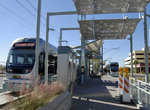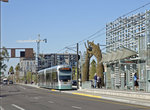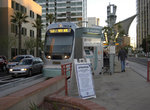Phoenix, Arizona
![]()
Phoenix Valley Metro LRV #135 on the Salt River Bridge. Photo by Zach Summer, April 2009.
Overview
Phoenix, the capital of Arizona, opened its 20-mile, $1.4 billion light rail line on December 27, 2008. This opening brought electric rail transport back to this desert city after an absence of 60 years.
Early Phoenix Traction History
The first street railway in Phoenix began in 1887 with mule-drawn cars. By 1893, there was 8 miles of track. The first electrification also occurred in 1893. In 1899, the system went under, and was bought by a General Sherman (not the same one who fought the Civil War), who named it Phoenix Railway Company. In 1911, an interurban line to Glendale opened.
The system reached its peak mileage in 1926, but Gen. Sherman, unwilling to continue service because of losses, abandons the system. The voters approved a city takeover, and 18 new double-truck Birneys were purchased. These endured through World War II, but buses replaced streetcars on several routes after the war. The end came on February 17, 1948 following a suspicious carbarn fire destroyed 12 cars in October 1947. Car 116, which has been restored by the Phoenix Trolley Museum, and another double-truck Birney, were saved.
How Light Rail Came To Phoenix
Phoenix, along with its suburbs, developed into a sprawling metropolitan area, much like Los Angeles and other metro regions. The automobile became the mode of choice, and public transport basically was non-existent--slow, infrequent, even ending service after 6:00PM in most cases. But congestion and air pollution were becoming concerns among civic leaders, environmentalists and transport experts. Could Phoenix develop a rail system?
The Arizona Rail Passenger Association proposed a light rail line, similar to the constructed alignment, in 1984. In 2000, voters approved a tax increase for transportation improvements. As plans for the $1.3 billion took shape, another boost came with the approval in November 2004 of Proposition 400, which extended the half-cent sales tax for an additional 20 years, and was slated to raise $8.5 billion in transportation construction funds, including the starter LRT route. Federal funding for the route, which started with $75 million grant in June 2004, helped pay for part of the project.
Construction of the line began in Tempe in February 2005. Most construction was completed by 2008, and LRV testing began that month. In the meantime, the coming of light rail brought an expansion in business venues along the route. Arizona State University, and the office building complexes along Central Avenue, are major beneficiaries and backers of LRT. Central Avenue was completely rebuilt as part of the project.
With testing and a major citizen safety outreach program under way throughout 2008, Valley Metro set a December 27, 2098 opening date. Riders jammed the trains all the time for the free rides given on the last few days of 2008. Revenue service started on January 1, 2009.
Station By Station
The route begins at Montebello/19th Avenue in northwest Phoenix and runs south to Camelback Road, with the 19th Avenue/Camelback station, where it turns east onto Camelback Road. The next station is 7th Avenue/Camelback. The next station, Central Avenue/Camelback, is located on a 45º angle cut-through just before reaching Central Avenue. After this, the line turns south again, running along the renovated Central Avenue corridor with stations at Campbell/Central, Indian School/Central, Osborn/Central, Thomas/Central, Encanto/Central and McDowell/Central. Following McDowell/Central, the tracks diverge somewhat for the crossing of the Deck Park Bridge, which is a linear park built over a submerged freeway. The Phoenix Trolley Museum is located at the northwest corner of this bridge. The tracks converge briefly before diverging again at Roosevelt/Central, where one-way traffic patterns take over for the journey through downtown Phoenix. Southbound trains use 1st Avenue as far as Jefferson, while northbound trains remain on Central. On both streets, the light rail line hugs the left curb. There is a loop at McKinley Avenue, where trains from the east can turn back. Stations are located at Van Buren/Central and Van Buren/1st Avenue, where Central Station-- a transit bus terminal-- is located, and at Washington/Central and Jefferson/1st Avenue. Central Station also features a display of historic transit equipment, comprised of two buses and ex-Toronto PCC 4607.
At the last two stations, the route turns east and will remain this way all the way out Washington and Jefferson Streets. The next stations are 3rd/Washington (westbound) and 3rd/Jefferson (eastbound) serving the Phoenix Convention Center, US Airways Arena (Phoenix Suns basketball) and Chase Field (Arizona Diamondbacks baseball). The tracks continue out Washington and Jefferson, and the tracks use what was once the second lane of a 4-lane street. Local traffic, with signal-controlled crossovers of the tracks, uses the left lane, while through traffic uses lanes 3 and 4. This continues out to about 25th Street, where double-track center lane operation resumes. Stations in the one-way area include 12th Street/Washington and 12th Street/Jefferson, and 24th Street/Washington and 24th Street/Jefferson. At 11th Street, there is a turnback loop, but unlike McKinley, trains can loop back in either direction. Ironically, Phoenix's last trolley line ran out Washington Street as far as 17th Street until 1948.
Once double track resumes, the line is fast and the signals are pre-empted (for the most part). Stations are located at 38th Street/Washington and 44th Street/Washington, where riders can transfer to the free shuttle bus to Phoenix Sky Harbor International Airport. (A people mover will be built, replacing the bus.) Following 44th Street, the line continues eastward. Just before passing under the Arizona 202 freeway, there is a two-track access route to the Valley Metro Light Rail Maintenance Facility, which is visible from the freeway. Entering Tempe, the route curves gently toward the southeast, and the station at Priest Drive/Washington is reached. Another station is located at Center Parkway/Washington before turning southeast and crossing the Salt River and into downtown Tempe. The bridge across the Salt River parallels the Union Pacific trestle bridge. Next comes Mill Avenue/3rd Street in downtown Tempe. The old grain elevator, a symbol of old Tempe, is north of the station. The next station is Veterans Way/College Avenue at the Tempe Transportation Center and the beginning of the route through the Arizona State University campus. Sun Devil Stadium is nearby. The second station serving ASU is University Drive/Rural Road. Following this stop, the line runs down Terrace Road toward Apache Blvd., where the route makes a 45º turn east. Along Apache Blvd., stations are located at Dorsey Lane/Apache Blvd., McClintock/Apache Blvd., Smith-Martin/Apache Blvd. and Price-101 Freeway/Apache Blvd. The end of the line, in Mesa, is Main/Sycamore. There are tail tracks to lay up trains here (similiar to those at Montebello/19th Avenue).
The line is separated from vehicular traffic throughout its entire route. On the Tempe end, there are intersections where crossing gates are utilized, but otherwise, most signals are set by train movements.
The general design of most stations is the same. Each includes what amounts to horizontal sails as canopies. There is also a group of vines in between mesh screens. The station artwork differs from station to station, and is designed by local artists and sculptors. Each station has electronic message boards. There is room for three-car trains at the stations, but at present, maximum train length is two cars.
Roster
The Valley Metro light rail fleet comprises 50 Kinkisharyo LRVs. Bodywise, they are derived from similar cars for New Jersey Transit (Hudson-Bergen, Newark) and VTA (San Jose), with a 70% low floor, but are much more streamlined. In appearance, they are similar to Seattle's fleet. However, they are designed for operation in triple-digit temperatures, with expanded air-conditioning capacity. There is room for four bicycles on board each car. Fifty percent of the parts on the vehicles are American made, and final assembly of the fleet was done at the Valley Metro shops.
Service and Fares
Service is from 5:00am to 11:00pm (the last train leaves each terminal at that time). 10-minute headways are offered on weekdays, with 15-minute service on weekends and holidays. 20-minute service is the rule after 7:00 PM. Currently, there is no late night/overnight service, but it is planned that during certain events, such as New Years Eve, home sports events, etc., the service will be extended til 2am or later.
Fares offered are single ride, day pass, and three-day, seven-day, and monthly passes. Fares are checked on the "honor system", or "proof of payment". Riders are required to have a valid pass or ticket before boarding and while on trains. Uniformed transit employees or police officers perform random checks of tickets and passes. Failure to produce a valid ticket or pass can result in a fine of up to $500.00. Check the official Valley Metro site for more fare details.
Photo Gallery
| Five Random Images | ||||
 Image 95895 (240k, 930x639) Photo by: Peter Ehrlich Location: Washington/44th - Sky Harbor Airport |  Image 95910 (183k, 574x864) Photo by: Peter Ehrlich Location: Washington/24th |  Image 96008 (169k, 930x618) Photo by: Peter Ehrlich Location: Montebello/19th |  Image 96022 (224k, 930x608) Photo by: Peter Ehrlich Location: Apache/Dorsey (Tempe) |  Image 96029 (202k, 930x618) Photo by: Peter Ehrlich Location: Central/Osborn |
Photos By Location
Photo locations: Metrocenter, Dunlap Avenue, Northern Avenue, Glendale Avenue, Christown, Montebello/19th, Camelback/19th, Camelback/7th - Melrose District, Camelback/Central - Uptown Phoenix, Central/Mariposa, Campbell/Central, Central/Indian School, Central/Osborn, Central/Thomas - Midtown Phoenix, Central/Roanoke, Central/Virginia, Central/Hoover, Central/Palm, Central/Encanto - Heard Museum, Central/McDowell - Cultural District, Central/Culver, Central/Deck Park, Central/Portland, Central/Roosevelt - Arts District, Central/McKinley, Central/Fillmore, Central/Van Buren, Central/Monroe, 1st/Van Buren, Washington/Central, Jefferson/1st, Jefferson/2nd, Washington/3rd, Jefferson/3rd, Washington/4th, Washington/5th, Jefferson/5th, Washington/7th, Jefferson/7th, 11th St. Loop, Washington/12th, Jefferson/12th, Washington/13th, Washington/16th, Washington/24th, Jefferson/24th, Jefferson/25th, Washington/26th, Washington/38th, Between 38th & 44th stations, Washington/44th - Sky Harbor Airport, Yard Leads/Entrance to Operations & Maintenance Center, Operations & Maintenance Center (Yard), Washington/48th, Washington/54th, Washington/Red Mtn. Fwy, Washington/Priest, Washington/Parkside, Washington/Center Pkwy., Salt River Bridge, 1st/Ash (Tempe), 3rd/Ash, 3rd/Mill (Tempe), Veterens Way/College Avenue (Tempe), Veterans/Stadium Dr., University Drive/Rural (Tempe), Terrace/Apache (Tempe), Apache/Dorsey (Tempe), Apache/Elm (Tempe), Apache/McClintock (Tempe), Apache/Smith-Martin (Tempe), Apache/Price-101 Freeway (Mesa), Sycamore/Main Street (Mesa), (Misc/Unknown)
Links
Official Site - Valley Metro. The official site of Valley Metro, including schedules, fares, and more.
Official Site - Phoenix Trolley Museum. The official site of the Phoenix Trolley Museum (or Arizona Street Railway Museum). It's open on Tuesdays and Saturdays, October through May.
Page Credits
By Peter Ehrlich.